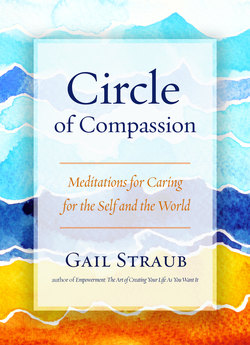Читать книгу Circle of Compassion - Gail Straub - Страница 5
2
ОглавлениеThis small book of meditations is for anyone who longs to put their compassion into action—to make compassion real in everyday ways. It’s for those who want to balance caring for self and caring for the world, because they recognize that the health of the human psyche and the health of the world are inextricably related, and we cannot truly heal one without healing the other. And it’s for those who understand that to deepen in compassion we need to open our hearts and face the suffering inside ourselves and in the world around us, because when we face suffering with an open heart we find momentary pain but we also find the doorway to lasting fulfillment and freedom.
These meditations are based on my book The Rhythm of Compassion: Caring for Self, Connecting with Society, which uses the metaphor of the in-breath and the out-breath to help people balance care of self and others. There’s a natural time for the in-breath of caring for self and family, and a natural time for the out-breath of caring for the needs of the world. The challenge is to become skillful in following your rhythm of compassion—knowing when it’s time to go inward and when to go out into the community.
These short meditations are designed to help you learn to follow your unique rhythm of compassion. In part the meditations are inspired by the most frequent questions and concerns expressed in letters and e-mails and at lectures from people who had read The Rhythm of Compassion:
• What are the most effective tools for balancing caring for self and others?
• How do I find the courage to face suffering—my
own, my family’s, and my community’s?
• How do I find the time to serve, or the time to care
for myself?
• How do I know when I’ve done enough for the
person I care for?
• What helps when the suffering of the world
overwhelms me?
• How do I cultivate genuine compassion rather than
moral do-goodism?
Though these questions came from a remarkably diverse cross-section of people—ministers, social workers, teachers, parents, therapists, business executives and managers, college students, activists, and healers—what they all had in common was a yearning to deepen in compassion, and a recognition that their own health was inseparable from the health of the world.
Circle of Compassion is designed for you to incorporate into your chosen spiritual practice. The book is divided into four main parts with several sets of meditations within each part, as well as a brief introduction on the specific purpose behind each part. I suggest working with one meditation a day. Start by gently following the pathway of your in-breath, and then your out-breath. Notice how much your breath can teach you about how to balance inner and outer. Continue gently following your breath until your mind becomes calm and receptive. Then read the meditation several times, letting the words enter your consciousness. If you follow this time of focusing on the meditation with a period of stillness the words will settle in you at a deeper level. Sometimes you may want to return to a meditation several times during the day, or work with an especially relevant meditation for several days.
I suggest working your way through all the meditations the first time through, as this lays the foundation for finding and following your rhythm of compassion. Then I invite you to use the meditations in a more spontaneous way. For instance if you know you are tired or reaching burn-out you can turn to part 2, “The In-Breath: Caring for Self,” and allow the “Claiming Self-Care” meditations to guide you towards self-renewal. Maybe you feel overwhelmed as you care for an aging parent or difficult co-worker, then turn to part 3, “The Out-Breath: Caring for the World,” and the meditations in “Cultivating the Four Qualities of Mature Compassion” can help you care for these people in a tender and skillful way. Or perhaps you are deeply concerned about caring for the earth, then you might turn to the meditations in “Practicing Mature Compassion for the Earth” and learn about ecological mindfulness.
My hope is that by using the simple meditations in this book you will learn to integrate your rhythm so your inner self-care helps you serve the world, and your caring for the world contributes to your soul. I believe that both our own well-being and the well-being of the planet depend on how skillfully we practice this integration.
